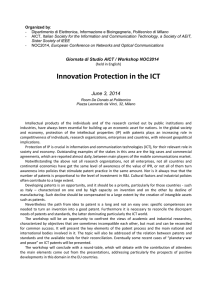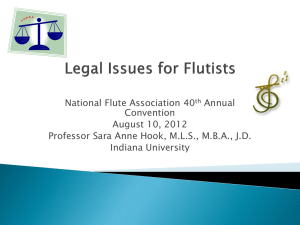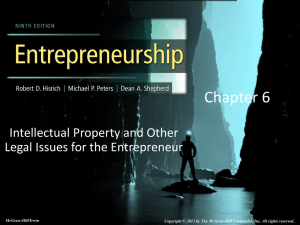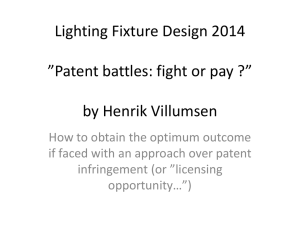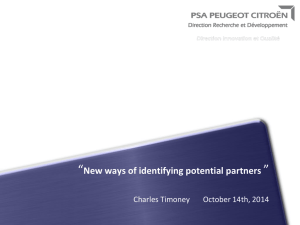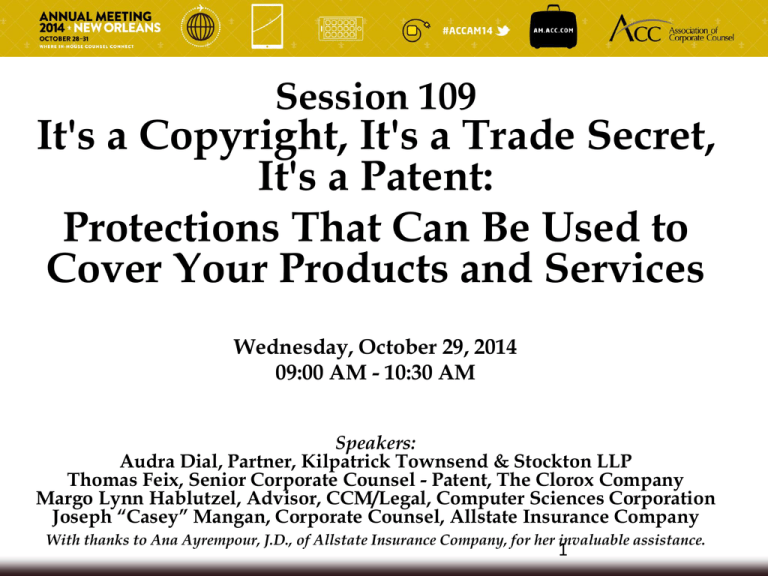
Session 109
It's a Copyright, It's a Trade Secret,
It's a Patent:
Protections That Can Be Used to
Cover Your Products and Services
Wednesday, October 29, 2014
09:00 AM - 10:30 AM
Speakers:
Audra Dial, Partner, Kilpatrick Townsend & Stockton LLP
Thomas Feix, Senior Corporate Counsel - Patent, The Clorox Company
Margo Lynn Hablutzel, Advisor, CCM/Legal, Computer Sciences Corporation
Joseph “Casey” Mangan, Corporate Counsel, Allstate Insurance Company
With thanks to Ana Ayrempour, J.D., of Allstate Insurance Company, for her invaluable assistance.
1
The Four Main Types of
Intellectual Property:
Trade Secrets: Secret technologies
Patents: Inventions
Trademarks: Designations of origin
Copyrights: Original works of creativity
Trade Secrets
Trade Secret Elements:
Secret
Gives a business a competitive advantage
Can protect ideas, methods, formulations
Must take reasonable efforts to maintain secrecy
Protection is against theft by others
Lost if confidentiality is breached legally
Reverse engineering can legally destroy protection
Protection can be indefinite if confidentiality is maintained
3
Trade Secret Theft
Normally – State Court Matter - UTSA
Federal Crime - Economic Espionage Act
of 1996
Prosecuted by the DOJ
oJail time
oFines
4
Recent Trade Secret
Legislation
The Defend Trade Secrets Act of 2014 (S. 2267)
(Senators Coons (D-DE) and Hatch (R-UT))
Amends the Economic Espionage Act (EEA) to provide for a
private, civil cause of action for trade secret misappropriation
Original (but not exclusive) federal jurisdiction; no preemption of
state law
Tracks substantive elements of Uniform Trade Secret Act; adds
an “interstate commerce” requirement
Plaintiff may seek ex parte order for court’s seizure of evidence
used to commit or facilitate trade secret theft
Senate Judiciary Committee held debate on this bill during
September 2014
5
Recent Trade Secret
Legislation
HR 5233, Trade Secrets Federal Protection Act, was
approved on September 17, 2014 by Judiciary
Committee of U.S. House of Representatives
Original (but not exclusive) federal jurisdiction; no
preemption of state law
Tracks substantive elements of Uniform Trade Secret
Act; adds an “interstate commerce” requirement
Also allows ex parte seizure application
6
2014 Legislation Status
First time for bicameral, bipartisan legislation on a
federal cause of action for trade secret
misappropriation
Senate Judiciary Committee held debate on The
Defend Trade Secrets Act of 2014 (S. 2267) bill
during September 2014
HR 5233, Trade Secrets Federal Protection Act,
was approved on September 17, 2014 by Judiciary
Committee of U.S. House of Representatives
Momentum building with broad-based industry
support
7
Trade Secrets vs. Patents
Trade Secrets
Potentially unlimited
duration
Not suitable for
anything that can be
reverse engineered
Must actively ensure
that secret stays
confidential
Protection only
against theft
Patents
Broader protection
Limited duration (20
years)
Require publication of
invention
8
Purpose of Patent
System:
Incentives/Promote Progress of Useful Arts
Invent and Innovate
Invest in Technological Development
Promote Disclosure
Quid Pro Quo (i.e., Consideration: Something
for Something)
9
Nature of a Patent:
A patent is a grant
Right to exclude others
Making
Using
Selling
Offering for sale
Does not grant owner right to make, use or sell
10
Types of Patents:
Utility Patents
Design Patents
Plant Patents
11
When to File:
Before Publication, Use, Sale or Offered for Sale
Rights in many foreign countries lost otherwise
Limited grace period still available in US under AIA
12
Why Get Utility Patents?
Protect Against Infringers
Exclude others
Generate royalty income by licensing
Infringement remedies include damages, injunction
Defensive Purposes
Prevent another from procuring a patent on same
invention
Deter others from bringing suit in view of ability to
counterclaim
Obtain rights of others by cross licensing
Recognition as Leader in Developing New
Technology
Term of protection ends 20 years from filing
13
Basic Conditions for
Patentability:
Utility
Novelty
Unobvious
Best Mode Described
14
Utility Patents –Patentable
Subject Matter
Statutory subject matter under 35 U.S.C. §101
includes any new and useful
Process
Machine
Manufacture
Composition of Matter
or any new and useful improvement to the above
15
Three Specific Exceptions to
§101’s Broad Patent Eligibility
Principles
Laws of Nature
Physical Phenomena
Abstract Ideas
16
Costs and Timing
Generally expensive to procure and maintain utility
patent rights
Application prep and prosecution costs anywhere from $10,000
to $100,000 or more depending on complexity
Official Fees payable upon filing (large entity) is $1,600
Total Maintenance fee payable over patent term is $12,600
Timing
Average time to receive first Office Action is 18.9 Months
Total pendency before final disposition (e.g., Allowance) is 27.5
months
This number jumps to 37.9 months when RCEs are filed
17
Costs and Timing
Options to consider for Quicker Allowance
Track One Prioritized Examination (PE) Program
Cost: $4,140 undiscounted fee (50% discount for small entity)
Timing: final disposition within 12 months
Current allowance rate is 46% to file
Accelerated Examination (AE) Program:
Must lower fee than PE ~ $140
Requires a pre-examination search document and support
document
Restrictions on number of claims and time to respond to office
actions
Patent Prosecution Highway (PPH)
First Action Interview Pilot Program
18
Recent Supreme Court
Patent Decisions
Alice Corp. v. CLS Bank International
(June 19, 2014)
Limelight Networks, Inc. v. Akamai
Technologies, Inc. (June 2, 2014)
19
Alice Corp. v. CLS Bank International
Issue: Statutory subject matter under 35
U.S.C. § 101
Subject: Patent for mitigating settlement risk
Held: Patent invalid for claiming “abstract
idea”
Courts to use two-step approach:
– 1. Determine whether claims directed to patentineligible concept (e.g., abstract idea)
– 2. If yes, then search for inventive concept in the
claim that transforms the nature of the claim into a
patent-eligible application
20
Takeaways from Alice Decision
Still no well-defined standards for what
qualifies as an “abstract idea” or “significantly
more”
Despite narrow holding Alice did establish
clear rule that had previously been subject to
debate: “mere recitation of a generic
computer cannot transform a patent-ineligible
abstract idea into a patent-eligible invention”
Need to incorporate new functionality
Improving speed/efficiency is not enough
21
Post-Alice Exam Statistics in
Software Art Units
On June 25th, the PTO issued preliminary examination
instructions to assist examiners when evaluating subject
matter eligibility of claims involving abstract ideas,
particularly computer-implemented abstract ideas, in
view of Alice Corp.
Drastic increase in 101 rejections: Number of actions
in the business-method art units with 101 rejections
issued in a two week period in July (78%) was nearly
three times that in a two week period in January (24%)
Reductions in Allowances: The proportion of
allowance issued in business-method art units has also
dramatically dropped since January (from an average of
23.6% to 4.5%)
22
Limelight Networks, Inc. v. Akamai
Technologies, Inc.
Issue: Induced infringement under 35 U.S.C. § 271(b)
Subject: Patent for content-delivery network
Held: When no direct infringement has occurred,
there is no induced infringement when “the
performance of all the patent’s steps is not
attributable to any one person”
Takeaway: There still exists an infringement liability
loophole since the Federal Circuit’s decision in
Muniauction prevents a finding of direct infringement
when two parties cooperatively infringe a method
patent, but when neither controls the other
23
Special Topic:
Coexistence of Patents and Trade Dress
McAirlaids Inc. V. Kimberly-Clark (4th Cir. June 25, 2014)
Georgia–Pacific Consumer Products LP v. Kimberly–
Clark Corp., et al., (7th Cir. July 28, 2011)
24
McAirlaids Inc. v. Kimberly-Clark
Issue: Utility Patents in the Context of Trade Dress and the
Functionality Doctrine
Subject: Patented pressure-fusion embossing process for
making a cellulose fiber product (bathroom tissue, paper towels,
diapers) and the trade dress for a specific embossed dot pattern
on the resulting product
Held: Genuine issue of material fact regarding functionality of
trade dress remained and that summary judgment was
inappropriate.
Court recognized:
utility patent serves as strong evidence of functionality
Rebuttable presumption of nonfunctionality created by McAirlaids’
federal registration for its dot pattern
Utility patent only covered process and not the specific embossed dot
pattern
The parties products could incorporate different embossed patterns
Conflicting evidence as to functionality
25
Georgia-Pacific Consumer Prods., LP V.
Kimberly-Clark Corp
Issue: Whether GP’s Quilted Diamond Design as embossed on toilet
paper was functional and therefor invalid as a trademark. Another case
involving Utility Patents in the Context of Trade Dress and the
Functionality Doctrine
Subject: Utility patents covering process for making toilet paper, design
patents covering Quilted Diamond design and a registered trade mark
for the Quilted Diamond Design
Held: Quilted Diamond design is functional and therefor trade mark for
the design is invalid. Summary judgment granted in favor of KC
Courts look to five factors to determine whether a design is functional:
Existence of a utility patent (yes)
The utilitarian properties of the item’s unpatented design elements (N/A)
Advertising statements (Yes, “quilted to absorb” and “quilted for
exceptional softness and comfort”)
Difficulty in creating alternative designs (GP utility patent disclosed Quilted
Diamond design as preferred embodiment)
Effect of the design on the product’s quality or cost (N/A)26
Takeaways
Utility patent protection, design patent protection
and trade dress protection may coexist if carefully
planned
Conduct analysis of product’s functional and non
functional aspects prior to seeking IP protection
Utility patents should focus on functional aspects
(be careful how you characterize the functional
aspects)
Seek design and trade dress protection on non
functional aspects
Marketing and advertising should support and not
thwart design and trade dress protection efforts
27
Design Patents
28
What do Design Patents Protect?
Design patents cover the design embodied in or applied to an article of
manufacture (or a portion thereof) and not the article itself
State another way, design patents cover the design for an article, not to
the design of an article
The design for an article consists of the visual characteristic embodied
in or applied to an article
Shape
Surface
Ornamentation
Both
29
What Design Patents Won’t Protect:
Utilitarian appearance and lack of ornamental
features (usually PTO threshold)
Functional (usually an issue enforcement
proceeding)
Hidden in use -- design never intended to be
noticed
30
Why Get U.S. Design Patents?
Design patents are inexpensive, with no postgrant fees
Design patents can be obtained in as quickly
as 3-6 months with advance planning and
expedited examination
Design patents last for 14 years from
issuance
31
Patenting Product Designs
DESIGN PATENT – an inexpensive way to:
Control the product configuration
Control the sale of replacement parts
Create a barrier to market entry by a
competitor
Create the possibility of creating perpetual
Trade Dress rights that can protect the
product configuration forever
32
Costs and Timing
For a normal, one embodiment design, with
no significant legal issues
Cost: $2,000 to file, $4,000 to grant
Timing: One to two years
For an expedited application, again one
embodiment design, with no significant legal
issues
Cost: $4,000 to file (includes $800 petition fee,
petition, and the cost of a patent search)
Timing: Three to six months
33
Considerations to Maximize
Design Protection
Things to remember:
1) The drawings define the scope of the claim
2) The patented design must be a three
dimensional object
3) Unnecessary elements in design patent
drawings provide unnecessary noninfringement positions
4) Design patents can give your client the time
to create protectable trade dress rights (i.e.,
satisfy showing of acquired distinctiveness)
34
Tips to Maximize Design Protection
Use broken lines to show
Unclaimed environment
Boundaries
Broken lines may be converted to solid lines during prosecution and vice
versa
May not be possible to add (new) broken lines in broadening continuation
applications . See In re Owens (Fed. Cir. March 26, 2013)
35
Tips to Maximize Design Protection
Use break lines to cover different sizes
36
Tips to Maximize Design Protection
Cover different design elements of interest in multiple embodiments
May lead to restriction, which is not necessarily bad
Can defer cost of filing divisional cases until parent case is allowed
Patent term begins at date of issuance
Tips to Maximize Design Protection
If color is important to the design, determine how it should be
protected
Broadest coverage is to claim contrast (solid black surface shading used to
represent the color black as well as color contrast)
Line for color to cover all shades
Submit color drawings for protection of a very specific color
Test for Infringement of a Design
Patent
To an ordinary observer, giving the
attention of a purchaser, the patented and
accused designs are substantially the
same such as to deceive such a
purchaser, in light of the prior art
Gorham v. White, 81 U.S. 511 (1871), as modified by Egyptian
Goddess, Inc. v. Swisa, Inc., 2008 U.S. LEXIS 20104, Case No.
2006-1562 (Fed. Cir. Sep. 22, 2008)
39
Test for Design Patent
Infringement
Egyptian Goddess eliminated the point of
novelty test (the accused design must also
“appropriate[d] the novelty in the patented
device which distinguishe[d] it from the
prior art)
Has Egyptian Goddess provided a broader
scope for all design patent holders as
predicted?
40
Selected Post-Egyptian Goddess
Cases
Arc'Teryx Equip., Inc. v. Westcomb
Outerwear, Inc., (D. Utah Nov. 4, 2008)
Richardson v. Stanley Works, Inc., (Fed.
Cir. 2010)
Apple Inc. v. Samsung Electronics Co.,
(N.D. Cal. Aug. 24, 2012)
Sofpool, LLC v. Kmart Corp., (E.D. Cal.
May 30, 2013)
41
Arc'Teryx Equip., Inc. v. Westcomb
Outerwear, Inc.
First case to apply the new ordinary observer test
Held: No infringement.
The ordinary observer would find the claimed zipper design to have
two sections, while defendant’s zipper has three sections. The court
made only passing reference to the prior art
42
Richardson v. Stanley Works, Inc.
“Egyptian Goddess allows courts to ignore and
discount unprotectable functional elements and still
apply the overall design comparison of the modified
observer test”
Finding of non-infringement affirmed
43
Apple Inc. v. Samsung Electronics Co.
Jury verdict of design patent infringement
The jury was instructed to use the modified ordinary observer
test and told that "[w]hen the claimed design is visually close to
prior art designs, small differences between the accused design
and the claimed design may be important in analyzing whether
the overall appearances of accused and claimed designs are
substantially the same"
44
Sofpool, LLC v. Kmart Corp.
The court did not specifically consider the prior art
Held: No infringement
By applying the ordinary observer test of Egyptian Goddess the
court ruled "no reasonable juror could find that an ordinary
observer would conclude that the taller, more elegant accused
pool embodies the squat pool plaintiff patented, or any colorable
imitation thereof"
45
Damages
35 U.S.C. 284. Damages
Same damages as for utility patent
Injunction, money damages, attorney’s fees
Reasonable royalty, price erosion, incremental profit
35 U.S.C. 289. Additional Remedy…
Infringer’s total profit for sale of an article including
the design
Not less than $250
Cannot recover profit twice – in other words you can’t
get 284 and 289 damages, and you can’t multiply 289
damages
46
Trademarks – What Are They?
• Common synonym = Brand Name
• Distinguishes your goods from others and
indicates their source (even if unknown)
• TM’s identify products (i.e., goods)
• SM’s identify services
• Trade Names identify businesses
47
Trademarks – What Are They?
Any word, name, symbol, or device used to
identify the origin or source of goods or
services
Rights arise through use of mark
Protection can be perpetual, so long as use
exists
Registration is advised, but not required
Clearance searches are recommended
before adopting a new mark
48
Trademarks v. Other IP Rights
• Patents/©’s come from US Constitution
– TM’s derive from common law and federal statute
• TM’s perpetual; Patents/©’s have fixed lives
• TM’s, Patents and ©’s are independent rights, can
co-exist, and can apply to same product (e.g.,
personal computer)
• TM’s - Use it or lose it
– Patents: No requirement to use, but must describe
sufficiently to allow others to make use
– ©’s: Registration alone allows owner to challenge
substantially similar works if infringer had access
49
Trademarks v. Other IP Rights
“The asserted doctrine is based upon the fundamental error
of supposing that a trade-mark right is a right in gross or at
large, like a statutory copyright or a patent for an invention, to
either of which, in truth, it has little or no analogy”
***
“In truth, a trade-mark confers no monopoly whatever in a
proper sense, but is merely a convenient means for facilitating
the protection of one's good-will in trade by placing a
distinguishing mark or symbol -- a commercial signature -upon the merchandise or the package in which it is sold”
United Drug Company v. Rectanus, 248 U.S. 90, 97-98 (1918)
50
Purpose of Trademarks
• Identify Origin
– TM’s help consumers identify goods
– TM’s make marketplace more competitive by
lowering search costs
• Quality Assurance
– Assures consumer he/she is getting anticipated
quality
– Challenges TM owner to maintain consistent
quality
51
Purpose of Trademarks
• Symbols of Goodwill
– TM’s allow producer (and not competitor) to enjoy
benefits of desirable product
– TM’s used over time can generate enormously
valuable goodwill (e.g., Coca-Cola, GE, Cheerios)
52
Trademark
Trademarks are ranked (and
protected) as follows:
Coined (Exxon) > arbitrary (Apple) >
suggestive (Dove) > descriptive (Vision
Center) > generic (aspirin)
Strongest marks are the most distinctive
53
Trademarks Can Expire
Lack of use.
Too much improper use – e.g., former
trademarks include: cellophane, escalator,
zipper, aspirin, thermos, yo-yo
These marks became the generic name of the
category, rather than a brand name for goods
from one source.
54
What Is Trade Dress?
“a combination of any elements in which a
product is presented to a buyer” including the
shape and design of the product
Art Attacks Ink
“essentially [a business’] total image and overall
appearance”
Blue Bell Bio-Medical
Trade Dress creates a visual impression that
functions like a trademark
55
3 Common Forms of Trade Dress
Product Packaging
(e.g., Wheaties Box)
Product Design or Product Configuration
(e.g., Rubik’s Cube or Goldfish crackers)
Websites
(e.g., Google Home Page)
Protecting Trade Dress
• Trade dress is protectable under federal
trademark and unfair competition law
(“Lanham Act” at 15 U.S.C. Sec. 1051, et seq.)
– Trade dress is registrable as a trademark/service
mark in the USPTO
– “Common law” trade dress is also protectable
57
Trade Dress Protection Challenges
Identifying what comprises the trade dress
Functionality – competitive fairness
(see Qualitex and TrafFix)
Distinctiveness Issues (Inherent versus
Acquired Distinctiveness)
(See Taco Cabana and Wal-Mart)
Ornamentation – merely decorative features
are not protectable (TMEP 1202.03(a))
Consistent use
10 Tips for Developing Protectable
Trade Dress
Develop distinctive designs
(i.e., flourishes)
Search and clear the design
Avoid functional designs
Review utility patents – trade dress
and utility patents don’t mix
But, design patents do
Do not develop utilitarian advertising
59
10’ish Tips for Developing Protectable
Trade Dress
Consider color as trade dress
Proceed with caution in the USPTO
Maintain trade dress rights through
consistent use
Develop advertising campaign and commit
to it for the longer run
Do “look for” advertising
Consider design patents
60
Trade Dress Cases
Supreme Court Cases
Two Pesos, Inc. v. Taco Cabana, Inc.
(1992)
Qualitex Co. v. Jacobsen Products Co.,
Inc. (1995)
Wal-Mart Stores, Inc. v. Samara Bros., Inc.
(2000)
TrafFix Devices, Inc. v. Marketing
Displays, Inc. (2001)
61
Trade Dress Issues: Product
Design
Product Design/Configuration:
Can never be inherently distinctive – must
demonstrate acquired distinctiveness under
§2(f) (Wal-mart v. Samara Bros.)
Utilitarian (functional) product features are not
protectable trade dress
Trade Dress Issues:
Functionality
Morton-Norwich Functionality Factors:
utility patent that discloses the utilitarian
advantages of the design sought to be
registered
advertising touting the utilitarian advantages
of the design
availability of alternative designs, and
whether the design results from a
comparatively simple or inexpensive method
of manufacture
Trade Dress: Georgia-Pacific
Decision
The quilted diamond design was found
functional
The Georgia-Pacific utility patents and
advertising both touted the utilitarian benefits of
the quilted design
Examples of Registered Trade
Dress: Product
Design/Configuration
Herman Miller, Inc.
Cinnabon, Inc.
(Supplemental)
Trade Dress: Registered
Product
Design/Configuration
Apple Inc.
Reg. No.
3,457,218
Apple Inc.
Reg. No.
3,470,983
Apple Inc.
Reg. No.
3,475,327
Trade Dress – Product
Designs held Not
Protectable
TARGET, IONIC PRO,
LLC, SYLMARK INC, ET
AL.
Sun Water Sys. v.
Vitasalus, Inc.
Trade Dress Distinctiveness:
Product Packaging
Product Packaging:
May be inherently distinctive for goods or
services
If not inherently distinctive, requires showing of
acquired distinctiveness (Wal-mart v. Samara)
Sometimes difficult to determine whether trade
dress is product design or packaging
In close cases, trade dress should be classified
as product design for which secondary meaning
is always required
Examples of Protectable
Trade Dress
Wolf Appliance, Inc.
McDonald’s Corporation
Examples of Trade Dress
Enforcement
Red Bull GmbH v. Matador Concepts, Inc.
Not Protectable Trade Dress
Nora Beverages, Inc. v. The Perrier Group of America,
Inc.
Under the circumstances of the case, the court noted
that "the presence of the prominent and distinctive
labels alone negates any possibility of a likelihood of
confusion"
Recent
Developments
72
B&B Hardware v. Hargis Industries
S.Ct. granted certiorari on 7/1/2014
B&B sued for trademark infringement claiming
that Hargis’ use of SEALTITE for “self-drilling
and self-taping screws” infringed B&B’s
SEALTIGHT trademark for fasteners used in the
aerospace industry
The TTAB sustained B&B’s opposition in view of
likelihood of confusion
73
B&B Hardware v. Hargis
Industries
D.Ct. and 8th Circuit - TTAB decision has no preclusive effect on
LOC issue in an infringement proceeding because it is not an
Article III court
S. Ct. will review:
(a) whether the TTAB’s finding of LOC precludes Hargis from
re-litigating the issue in an infringement proceeding where
LOC is an element; and
(b) if issue preclusion does not apply, whether district court
was obliged to defer to the TTAB’s finding of LOC absent
strong rebuttal evidence
74
Hana Financial v. Hana Bank
Sup. Ct. granted cert. on 6/23/14 on issue of whether
“tacking” is an issue of fact for jury or of law for court
Hana Financial alleged that “Hana Bank” infringed its
trademark rights
Hana Bank argued that it could tack “Hana Overseas Korean
Club” to its later use of “Hana World Center” and that “Hana
World Center” could then be tacked to “Hana Bank”
Tacking doctrine permits a party to “tack” the use of an older mark
onto a new mark for priority purposes; however, marks must be
“legal equivalents”
D. Ct. held that tacking is a factual question and submitted it
to the jury which ruled for Hana Bank
Ninth Circuit affirmed, but indicated the result would perhaps
be different if tacking were considered a legal issue
75
Pom Wonderful v. Coca-Cola
Decided 6/12/14
Pom sued Coca-Cola under the Lanham Act, which
prohibits false and misleading statements about a
product, because Coca-Cola’s labeling of a product as
“pomegranate blueberry favored blend of five juices” was
misleading, as it only contains 0.3% pomegranate juice
and 0.2% blueberry juice
Coca-Cola argued that the FDA approved the label and
that the approval precluded any claims under the
Lanham Act
76
Pom Wonderful v. Coca-Cola
Lower courts agreed with Coca-Cola
and ruled that Pom could not sue
because the FDA’s rules superseded
other claims
S. Ct. disagreed and allowed Pom to
proceed with its Lanham Act claim
No statutory text or principle precluded
Lanham Act suits of this nature
Competitors may bring claims that
challenge food and beverage labels that
are regulated by the FDA
77
McDonald’s Corp. v. McSweet
Decided 9/29/14
TTAB sustained McDonald’s opposition
to application for MCSWEET for
gourmet pickled vegetables, finding:
Likelihood of confusion
Likelihood of dilution
Bd. determined that McDonald’s had
proven through extraordinary sales and
advertising spend that it owned a
family of “Mc” marks (i.e., Mc + generic
or descriptive term)
78
McDonald’s Corp. v. McSweet
Witnesses testified that customers spontaneously insert “Mc” before food
items purchased at the restaurants, even when in error
Bd. found “Mc” family famous, with sales since 1955 through 14,000
restaurants and with advertising that at times focused on the “Mc” element
as the central advertising message
Similarities in meaning, appearance and commercial impression made
confusion likely
Goods are sufficiently related to meet the LOC test
Channels are similar enough, in that some restaurant providers sell through
supermarkets where MCSWEET items are sold (even though McDonald’s
didn’t)
Bd. found “Mc” family is famous and had been before use of MCSWEET
mark, and that almost all of the 6 “blurring” statutory fame factors cut in
favor of McDonalds
79
McDonald’s v. McSweet
Survey evidence from McDonald’s found
persuasive
Opposer's survey demonstrated "a
substantial degree of association”
between MCSWEET and McDonald’s
and the "Mc" marks: "67% or two out of
three individuals who encounter the
MCSWEET term associate it with
Opposer, McDonalds and its 'MC'
marks."
Board found that the mark MCSWEET "is likely to impair
the distinctiveness” of Opposer’s family of “Mc” marks
and is therefore likely to cause dilution by blurring within
the meaning of Section 43(c)
80
Nationstar Mortgage v. Ahmad
Decided 9/30/14
TTAB sustained a fraud claim for the first time since 2009 Bose decision
Bd. found the financial services cited in the in-use application were
fraudulent
Fraud must be proven with clear and convincing evidence
Statements made on good faith belief are not fraud
Applicant’s testimony that was evasive and inconsistent – given his
knowledge of state licensing requirements -- was problematic
Overall, Ahmad’s testimony was not credible nor corroborative of his
positions taken in litigation
Bd. also found fraud was committed knowingly and with intent to deceive Bd.
Bd. distinguished Bose in which there was a nuanced question of trademark
law on which the applicant had made a mistake which was not fraud
81
Nationstar Mortgage v. Ahmad
Fact that applicant – a non-attorney – filed his
application without counsel was no excuse
Declaration makes clear that the statements made in
the application if untrue are subject to criminal
penalties
Conclusion: Bd sustained opposition and thus
declined to consider the additional opposition
grounds of likelihood of confusion and lack of
bona fide intent
82
Right of Publicity
The Right of Publicity is the right to control
the commercial use of one’s identity
Elements:
“name, image and likeness”
Survives death in some states (not NY)
Laws vary by state
California: Life + 95 years after death
Indiana: Life + 100 years after death
MICHAEL
JORDAN
v.
JEWEL- OSCO
FACTS:
Ad was published in a commemorative issue of Sports Illustrated. It
reads: “A Shoe In! After six NBA championships, scores of rewritten
record books and numerous buzzer beaters, Michael Jordan's
elevation in the Basketball Hall of Fame was never in doubt! Jewel–
Osco salutes # 23 on his many accomplishments as we honor a fellow
Chicagoan who was “just around the corner” for so many years.”
The Northern District of Illinois ruled that this is constitutionally protected
free speech because there was no commercial transaction involved.
On appeal, the 7th Circuit held:
The advertisement did not merely congratulate Michael Jordan but also
promoted the grocery stores by use of their logo and slogan. As such, it
constituted image advertising, which is a form of “commercial speech”.
This decision defeated Jewel’s First Amendment defense and permitted
Jordan’s case against the supermarket chain to proceed under Illinois
publicity law.
Jordan v. Jewel Food Stores, Inc., 12-1992, 2014 WL 627603 (7th Cir. Feb. 19, 2014)
Just Last Week:
86
Sivero v. Fox Television
• Frank Sivero played mumbling Mafioso Frankie Carbone
(ostensibly based on real-life gangster Angelo Sepe) in
Martin Scorsese’s 1990 gangster epic Goodfellas.
• He is suing Fox Television, arguing that the Fat Tony
hechman Louie (who first appeared on The Simpsons in
1991) is clearly modeled on his Goodfellas character.
– Reportedly the voice was modeled after Joe Pesci’s character
• Sivero is seeking $250 million in compensation for
unauthorized use of the likeness.
• Sivero was recently successful in having his likeness
pulled from promotion by Deli Belly in Southern
California for its “Frank Carbone” sandwich. He allowed
photos to be taken while he ate there for souvenir
purposes but not to be used in advertising.
87
COPYRIGHTS ©
Used by permission of Dave Kellett. ©2014 Dave Kellett. All Rights Reserved.
88
Copyrights
Protects original works of authorship
Books, movies, music, pictures, program code, dance
Creation must be reduced to a “fixed medium of
expression” – written, recorded, etc. – not just ideas
Works are protected upon creation
Registration is advised, but not required
Use of © does not require registration
Conveys a “bundle” of rights, including reproduction,
distribution, performance, creation of derivative
works, and others
Assignment of copyrights must be done in writing.
Each right may be assigned separately.
89
Examples of Creativity
Literary works –
books, newspapers, periodicals, manuscripts
Dramatic works –
plays, musicals, operas
movies, television shows
Art –
paintings, sculptures, maps
Music
Composition
Recording
Architectural works –
building plans
90
Specifics of Copyright
© Protection
Copyright term –
Life of author plus 70 years
95 years from publication for a work made for hire
(corporate authorship)
Note: Due to changes in copyright law, there is a
recognized cutoff of 1923 – creations prior to that are in
the public domain
Some special situations, such as newly discovered
works in EU which can be protected for 25 years.
91
Plagiarism and Infringement
• “If you steal from one author it's plagiarism; if you steal
from many it's research.” Wilson Mizner
• Plagiarism is a form of infringement
• “Fair Use” is a defense to charges of infringement
–
–
–
–
the purpose and character of your use
the nature of the copyrighted work
the amount and substantiality of the portion taken, and
the effect of the use upon the potential market
• Infringement is not based upon quantity but value:
– There is no “10% Rule”
– Harper & Row v. Nation Enterprises, 471 U.S. 539 (1985) –
Gerald Ford’s memoir – use of 300-400 words out of 500
pages was not “fair use”.
92
Overlapping IP Protection
An ornamental design may be protected by
copyright as a work of art and also may be the
subject of a design patent.
Where a copyrighted artistic representation
identifies a product or service, it also may be the
subject of a trademark.
In some instances, an industrial design can span
patent, trademark and copyright protection.
Some protection schemes require you to choose
93
THE COCA COLA CONTOUR
BOTTLE
In 1915, Alexander
Samuelson and Earl R.
Dean designed the
original "hobble skirt"
contour bottle
The first design
patent on the bottle,
D63,657, was granted
on December 26, 1923,
to the bottle
manufacturer
94
The Coca-Cola Bottle
The Coca-Cola Company
received a second design patent
for the contour bottle on March
24, 1937, preventing imitation of
the bottle for another 14 years.
The bottle became so well
known that it became
synonymous with the Coca-Cola
product.
The Coca-Cola Company sought
and obtained a federal
trademark registration for its
contour bottle on April 12, 1960,
enabling the company to
safeguard the bottle design
indefinitely.
95
OTHER IP RIGHTS IN PLAY –
COCA COLA
Trademark:
Bottle, COCA-COLA,
COKE
Copyright:
Bottle, keychain,
advertising
Trade secret:
The formula (SHHH! It’s a
secret!)
Right of publicity:
Use of sports
figures
96
Exclusionary Strategy
Defined
A strategic process that utilizes a
combination of barriers to prevent or
slow competitive entry into product
areas XYZ Corp plans to own
AND
Present view of XYZ products and
technologies as Sustainable,
Enforceable, and Exclusive
97
Importance of
Exclusionary Strategy
In order to win with an innovation strategy the
innovation must be sustainable
History has shown that innovations with at least
a one year lead time will usually dominate
market share for many years even against
preferred products
98
Elements of Exclusion
Competitive
Threat
Marketing
IP
Competitive
Threat
Cost
Launch
Timing
Products
Exclusionary horizon
Competitive
Threat
Competitive
Threat
99
Exclusionary Rating
Overall Rating Launch Timing Advantage
Cost Advantage
Consumer/ Marketing
Advantage
Patent/IP Advantage
1
Comp 1st to launch
L
Disadvantage
Significant
Disadvantage, Comp has
more and broader IP
2
Same launch timing
L
No Advantage
No Advantage
3
6mo - 1yr
M
Slight Advantage
4
1yr - 2yrs
M
Significant Advantage
5
>2yrs
H
Huge advantage
Slight Advantage
Significant Advantage,
Difficult to design
around, forces comp to
make compromises
Huge Advantage Broad
IP, Very difficult to
design around
Determined as
average of all
exclusionary
elements of IP,
Timing, Cost,
and Marketing
Factors: Supply
chain control,
Factors: Supply chain
scale, technology
control, trade sectrets/know complexity,
how , technology complexity, manufacturing
manufacturing process,
process,
partners/License
partners/License
Factors: brand equity or cobrand, regulatory,
trademarks, patents,
Factors: patents,
product performance claim trademarks, trade
(60/40 w in),
secrets, license,
customer/consumer need supplier, partner
100
Align Exclusionary Strategy with Product Development
Timeline
Discovery
Opportunity
Assessment
Development
Commercialization
Market
Intro
Consumer Insights
IP Landscape
(identify
Competitive &
White Spaces)
Evaluate Launch
Timing & Costs
Advantages
Execute Strategy by filing
design patents, TMs,
registrations, etc.
Combine 4
Exclusionary
Elements into Holistic
Strategy
Consider and implement
marketing plans to develop
protectable trade dress (piggy
back on exclusivity from
design patents if possible)
Actively monitor
competitive
activity and
adjust strategy
accordingly
Technical Insights
Product Ideas
Opportunities
Identified
No exclusionary
efforts
Identify potential
partners,
Licenses
Analysis of
competition
Initial Marketing plan
Initial regulatory plan
Brainstorm ideas and
workarounds
Capture and prioritize
invention
disclosures
Develop competitive
response scenarios to
test strategy
Begin Freedom-toOperate activities
Monitor competitive
activity
Execute Strategy by
filing patents (early
and often) and TMs
Conduct IP Gap
analysis and capture
& file on inventions as
appropriate
Actively monitor competitive
activity and adjust strategy
accordingly
Consider continuing patent
filing strategy to address IP
gaps (both utility and design)
Consider “fast Lane” patent
prosecution options
101
Consider
continuing patent
filing strategy to
address IP gaps
(both utility and
design)
Consider trade
dress registration
Scenarios
102
Scenario 1 – The New Widget
(upstream product innovation discovery work)
You are in-house counsel at XYZ Corp, a consumer products company
that manufactures widgets. A “Skunk Works” faction within the
product development group of XYZ Corp has come up with an idea for a
new product innovation platform that would leverage and expand use
of its core widget technology into new consumer product areas.
At present, XYZ Corp’s widget technology is protected by a combination
of patents and trade secrets (primarily process know-how). The new
product innovation platform would require one or more enabling
technologies not currently within the core competence of XYZ Corp’s
R&D department.
XYZ Corp has decided on a parallel path forward: (1) do all the new
product innovation platform work in-house; (2) collaborate with an
external partner having expertise in one of the identified enabling
technologies to support a second development option for the new
product innovation platform work.
What should you be thinking about?
103
Scenario 2 – Product Launch
The product innovation platform work was successful and
now the product launch team of XYZ Corp wants to bring
the first of the new manufacturing products to market.
The new manufacturing product has both new functional
features and a new appearance. The product launch team
has come to you as in-house counsel and they are in the
midst of naming the product, putting together marketing
materials, and will be showing off the product at the
upcoming Widget World Expo. They are having a custombuilt display case made for the Expo, and are sending out a
prototype to be mounted inside.
What should you be thinking about?
104
Scenario 3 – One Year Later
The new manufacturing product has now been in market for about 12
months and a competitor has answered with a competitive response that is
beginning to take away sales. In order to boost sales, XYZ Corp is interested
in using characters that children can relate to. Disney licensed its copyrights
(and trademarks) for the movie “Toy Story” to XYZ Corp, allowing XYZ Corp
to use characters and scenes from the movie in a series of posters for the
new product. Hoping to get its employees excited and involved in the
process, XYZ Corp decides that it will invite its employees to submit
paintings of Buzz Lightyear from Toy Story, with the understanding that the
employee with the best painting would be offered a contract to paint all
the Toy Story characters as an entire series. XYZ Corp urges its employees
to use their own interpretation, but to make sure that the Buzz Lightyear in
each painting is very recognizable as “everybody’s Buzz Lightyear”.
Continued
on next slide
105
Scenario 3 – continued
Jenny, an employee at XYZ Corp, printed out several photos of Buzz and
used her recollections of the movie to paint Buzz Lightyear. Jenny’s
interpretation of Buzz was chosen to be the winner. XYZ Corp offered Jenny
a contract to do the series, but Jenny read through the terms and declined.
XYZ Corp then awarded the contract to
employee James. XYZ gave James the
painting made by Jenny and asked him to
“clean it up.” James did so, and now all the
paintings are completed just in time for the
new product launch.
Jenny is enraged that James “stole” her
painting and copied it. Jenny has a copyright
registration on her painting.
What should you be thinking about?
Should XYZ
106Corp be worried?
Scenario 4 – Advertising
XYZ’s marketing team is putting together an advertisement. Mary from
marketing is interested in using individuals from the community in the
ad in order to make the brand approachable. She is on a tight schedule
and asks you if she needs to do anything before filming the members
of the community she has chosen to be in the commercial.
Mary also needs music for the commercial and she loves Adam
Levine’s distinct voice. Jessica is on Mary’s marketing team and was
ecstatic to realize that her neighbor’s cousin is a singer and sounds
exactly like Adam Levine. Jessica suggests that they reach out to the
cousin and have him perform a song for the commercial.
What should you be thinking about?
Are there any concerns Mary and Jessica (or XYZ) should have about this commercial?
107
GLAD® Force Flex®
Case Study
108
109
GLAD® Force Flex® Case Study
Rating ~ High
GLAD Strategy
Competitive
Position
Outcome
Launch Timing
First to market
Not technology driven
Significant manufacturing
complexity and capital a
hurdle to competitive entry
Significant retooling needed
to develop competitive
product.
GLAD Force Flex grew the
trash bag category and
product out performed all
other trash bags at launch.
Cost
GLAD’s Technology was a
“costovation” … less resin =
less cost
Expected response was
thicker (=stronger) bag, a
significant cost disadvantage.
Product/ Consumer
Visible superior puncture
resistance (reason to believe)
Slight advantage in equity
around toughness of bags
using traditional film
technology.
Huge opportunity to establish
trade dress via “look for”
advertising.
Intellectual Property
Near term: Unexpected
result was Katrina and
resultant spike in resin costs
(GLAD felt less impact than
Competitors due to lower
resin usage)
Process know how
No competitive IP.
12 utility patents and 1 design
patent granted at launch with
more applications pending
Opportunity for competition to
make thicker bag without
infringing.
2 registered word marks and
registered trade dress on
product configuration
A Branded competitor
launched a thicker bag with
a FLEX type trademark and
embossed grid design on
bag to compete after 1 year
but ultimately discontinued
product.
Long term: product now off
patent, GLAD remains
vigilant in enforcing its
trademark rights
110
Thank you!
111



